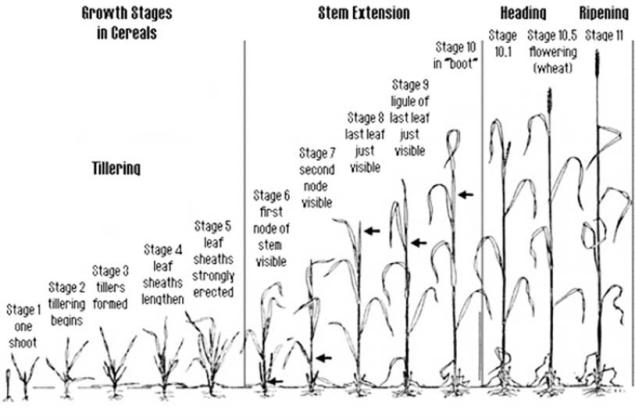Topdressing Small Grains
Whether you are growing small grains for grain, grazing or hay or silage production, proper timing of topdressing is critical to your overall yield. Timing is especially critical if you are planning to harvest grain. Regardless of how you are using your small grains, ideally topdressing will occur in time for the N to be moved into the rootzone well before jointing (Feekes 5) begins. Timing is the most important aspect in getting the most economic benefit from your nitrogen topdress input cost.
Jointing or the growth stage Feekes 5 in small grains refers to the time in the development of the plant when an individual stem now has a node in it (the stem is elongating as the head has been initiated). After this point most all tillering of the plant will cease. If you see a few plants showing signs of jointing across the field and you have yet to topdress, you should do so as soon as possible and then water-in or hope for some moisture to move N into the root zone.
Why is it important to topdress while plants are still tillering and what is tillering? Tillers are additional stems that develop off the main shoot of the plant. Primary tillers form in the axils of the first four or more true leaves of the main stem. Secondary tillers may develop from the base of primary tillers if conditions favor tiller development. So, in a nutshell tillering is what adds additional forage to your stand, thickens it up. Even a thin stand of small grains can benefit from topdressing as it will help increase tillering and help to compensate for a thin stand.
When will we reach jointing or Feekes 5? It seems each year this question gets harder to answer. It is more dependent on weather than the calendar for this reason scouting is the most accurate means of determining jointing. However, an average time frame would probably be late-February to mid-March. Often, if you see some moisture in the forecast this time of year, it is probably best to go ahead and get your topdress out. Unless a heavy rain of several inches is predicted then you would stand the chance of losing some N to runoff.
Typically, UAN or Urea are utilized for topdressing small grains, but topdress sources for N vary and I recommend you check prices for your best option. If applying early and using urea, you might consider a mixture of coated and uncoated urea to provide some initial N and some later released N. For grain production a rule of thumb is 1.5 to 2 pounds of N per bushel of estimated grain. For grazing typically 50 to 60 units of N are suggested. The good news is that even though fertilizer prices are still high they are below the last two-year levels at least for now.


